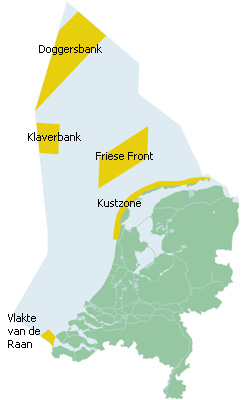Cleaver Bank on:
[Wikipedia]
[Google]
[Amazon]
 The Cleaver Bank ( Dutch: ''Klaverbank)'' is a sandbank in the
The Cleaver Bank ( Dutch: ''Klaverbank)'' is a sandbank in the
 The Cleaver Bank ( Dutch: ''Klaverbank)'' is a sandbank in the
The Cleaver Bank ( Dutch: ''Klaverbank)'' is a sandbank in the North Sea
The North Sea lies between Great Britain, Denmark, Norway, Germany, the Netherlands, Belgium, and France. A sea on the European continental shelf, it connects to the Atlantic Ocean through the English Channel in the south and the Norwegian Se ...
about off the west coast of the Netherlands
, Terminology of the Low Countries, informally Holland, is a country in Northwestern Europe, with Caribbean Netherlands, overseas territories in the Caribbean. It is the largest of the four constituent countries of the Kingdom of the Nether ...
and south of the Dogger Bank. The size of the bank is about 1235 km2. The bank is 30-40 metres below sea level.
The Cleaver Bank is an open-sea reef in the terms of the European Habitats directive and has been registered with the European Union as a Natura 2000 site. The bank originated as a terminal moraine of a glacier during one of the Ice Ages.
The surface of the bank partly consists of gravel and larger cobbles. Due to the relatively great depth of the Cleaver Bank, the soil is only seldom, in very heavy weather, moved by wave action. Because the gravel is relatively poor in silt and the transparency is great, there is enough light to allow for the growth of calcareous red algae
Red algae, or Rhodophyta (, ; ), make up one of the oldest groups of eukaryotic algae. The Rhodophyta comprises one of the largest Phylum, phyla of algae, containing over 7,000 recognized species within over 900 Genus, genera amidst ongoing taxon ...
. The benthic fauna on the bank contains species that live on a hard substrate, such as sea anemones and polyps. Rare species living on Cleaver Bank are '' Thracia convexa'' and the '' Rayed artemis''. The bank is used by herring for spawning. In addition, the soft coral type dead man's finger is found here.
A 60-metre-deep channel, called the Botney Cut, runs through the Cleaver Bank. Animals like harbour porpoises, minke whales, and white-beaked dolphin live there, mainly in the summer.
Conservation
In 2001, the Dutch government considered the Cleaver Bank as a potential area for mining gravel. After making an Environmental impact assessment the plan was abandoned. The Cleaver bank is in 2015 considered for protection as a Marine protected area. The Greenpeace organisation considered the actions of the Dutch government in this direction too slow and sank some large boulders on the seabed in May 2015 to increase the nature value. Dutch fishers lifted the boulders on 16 June 2015, because they were afraid the boulders would damage their fishing gear.References
{{Reflist Sandbanks of the North Sea Shoals of the Netherlands